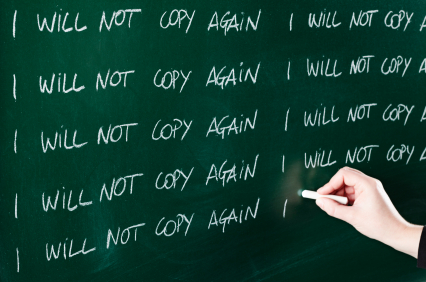by Shari Finnell
In this age of technology, cheating has never been easier.
No, I’m not talking about cheating on your better half. That’s an entirely different story that – as we would say here at Slingshot – doesn’t fit into our RELEVANCY standards for this particular blog.
OK. Back to this cheating thing. Here are the scenarios I’m talking about:
-
- Navigating the internet.
- Finding an incredibly well-written blog post that’s really, really similar to the assignment/blog/presentation you’re working on.
- Coming across a section of that story that says exactly what you would say … and pretty much the way you would say it.
- Copying and pasting said section into your story, changing a few words, and moving on because you just saved yourself about 45 minutes of work … and, besides, who’s looking?
It’s considered “cut-and-paste” plagiarism or duplicate content — stuff that could potentially cause your site to be penalized by search engines. If you have multiple people regularly populating your site with fresh relevant content — which you should — it makes sense to review your policy on this practice, if you already haven’t.
Apparently, this type of plagiarism is not only rampant; it appears many people are becoming immune to the illegitimacy of the practice.
In a study by the Donald McCabe Center for Academic Integrity, a majority of students (68 percent) didn’t think it was a serious issue. Education Week revealed 66 percent of college students admitted to plagiarizing by pulling content from the Internet.
And according to the U.S. News and World Report, 80 percent of so-called “high-achieving” high school students admitted to cheating in a survey, while 51 percent of high school students didn’t think there was anything wrong with it. A vast majority — a whopping 95 percent — said they had not been caught. College students didn’t fare any better in their attitudes: Nearly 85 percent said it was necessary to get ahead.
With these many incidences, it isn’t a stretch to assume that an employee (or you) could be taking a shortcut every once in a while when producing content for your site. It’s also possible that you’re not guilty of plagiarism, but have very similar content on different pages of your site – which is all the same in the eyes of search engine bots. Duplicate content serves no purpose … it will do nothing to assist in your efforts to boost your SEO ranking.
In more egregious cases — let’s say you pulled 10 percent of a Wikipedia entry to craft your content—your site actually could catch Google’s attention and be penalized as a result.
To ensure your company’s practices against plagiarism is intact, take the following steps.
-
-
- Review Google’s directive on duplicate content, and at the same time, take steps to protect your hard-earned original content from being used on a competing site.
- Make sure you properly credit any source you use.
- Avoid quoting verbatim sections of copy from your source — even if you properly quote the source. When you’re conveying instructions from a source, make sure you rephrase the copy so that it is not duplicate content. Better yet, just insert a hyperlink connecting to the instructions on the source’s website.
- Take the time to have an original thought or point of view. When you rush through the process of developing content against an unreasonable deadline (i.e. you give yourself an hour to complete a blog), you run the risk of taking plagiaristic shortcuts.
- Use CopyScape. To make sure your content isn’t subject to a duplication penalty and is seen as authoritative by bots, run sections of your content through CopyScape – an Internet plagiarism detector. If it comes up as duplicate, reassess your content and your practices.
-